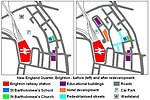Brighton Toy and Model Museum

Brighton Toy and Model Museum (sometimes referred to as Brighton Toy Museum) is an independent toy museum situated in Brighton, East Sussex (registered charity no. 1001560). Its collection focuses on toys and models produced in the UK and Europe up until the mid-Twentieth Century, and occupies four thousand square feet of floor space within four of the early Victorian arches supporting the forecourt of Brighton railway station. Founded in 1991, the museum holds over ten thousand toys and models, including model train collections, puppets, Corgi, Dinky, Budgie Toys, construction toys and radio-controlled aircraft.The display area includes large operational model railway layouts (in 0- and 00-gauge), and displays of period pieces from manufacturers and brands including Bing, Bassett-Lowke, Georges Carette, Dinky, Hornby Trains, Märklin, Meccano, Pelham Puppets and Steiff. It also includes individually engineered working models including a quarter-scale traction engine, steamroller and Spitfire fighter plane in the lobby.
Excerpt from the Wikipedia article Brighton Toy and Model Museum (License: CC BY-SA 3.0, Authors, Images).Brighton Toy and Model Museum
Trafalgar Street, Brighton Round Hill
Geographical coordinates (GPS) Address Phone number Website External links Nearby Places Show on map
Geographical coordinates (GPS)
| Latitude | Longitude |
|---|---|
| N 50.828611 ° | E -0.140833 ° |
Address
Brighton Toy and Model Museum
Trafalgar Street 52-55
BN1 4EB Brighton, Round Hill
England, United Kingdom
Open on Google Maps










